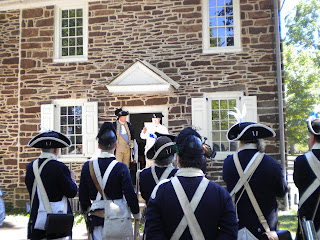The following is a passage from the novel: "Then...A Patriot I'll Be". It describes the preparations that were involved just before two ships in the 18th century met at sea in preparation for a ship to ship battle...
...Now, just for sake of knowledge, I will attempt to detail what was
involved when the signal was given for battle stations, or “beat to quarters”.
My father, being a sailor in the merchant service, had many acquaintances that
had served aboard a warship. He relayed down to me some stories he had heard, so
I acquired some knowledge of ship to ship battle. When the officer of the watch
gave the command to “beat to quarters” a drummer would beat to a tune familiar
to all on board. This tune meant, “Get to battle stations lads, there is to be
a fight ahead”. With that, the crew of the vessel would clamber about the ship
to pre-determined positions, such as their place in the gun crew below decks,
as the marines climbed the masts to get to the fighting tops. Officers would
take their place amongst their men, to shout out commands over the thundering
fire of the cannon, and the sailors assigned their task would ascend to the
cross trees, and yards in order to bring up, or unfurl the sails as their
orders came to them. A scene that surely looked to be chaos, but in reality it
was a well choreographed dance, where everyone knew their part. The ship itself
would have to be prepared for the fight as well. Bulkheads below decks would be
removed to make way for the powder monkeys running to and fro with their
precious charges for the guns. The decks above and below would be covered with
sand as to allow the men proper footing when running through the blood of their
wounded comrades.
Sand was also made to cover the floor of the surgeon’s
cockpit. This was also meant to sop up the blood that poured on the floor as he
was performing his amputations, and other treatments for the injured. The
surgeon and his mates would prepare a bucket for the disposal of amputated
limbs. The “instruments” were laid out on the makeshift operating table, that not
hours before was used by the crew to eat dinner on, and will be used for the
same purpose hours later.
Being made of wood, the ship was prone to fire. For
that measure, the powder magazine’s canvas curtains were wet down to prevent any
unwanted sparks (for obvious reasons). The stove fire was put out, and leather
“fire buckets” were filled with water or sand, and placed about the ship to
douse any fires that may arise. On a ship, the quarters were cramped with not
only men, but also livestock and stores of furniture, and supplies. The
livestock and such stores were usually put into the ship’s boats, lowered, and
towed behind the ship by a rope, or simply set adrift with intentions on
bringing them back on board after the fighting had ceased. While this was all
going on, selected members of the crew would see to it that all hammocks were
placed on the upper deck, and into the netting constructed above the sides of
the ship’s walls and rails. This was for the design of a barrier to protect the
crew against musket fire, and splintered pieces of the ship that may flail
about during battle...
 |
| The Gundeck of a Typical 18th Century Sailing Warship |
 |
| Officers Wardroom - Note the Leather "Fire Buckets", and Removable Bulkheads |










